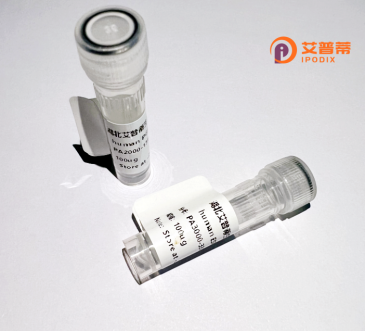
| 纯度 | >90%SDS-PAGE. |
| 种属 | Human |
| 靶点 | ZNF461 |
| Uniprot No | Q8TAF7 |
| 内毒素 | < 0.01EU/μg |
| 表达宿主 | E.coli |
| 表达区间 | 1-563 aa |
| 活性数据 | MAHELVMFRDVAIDVSQEEWECLNPAQRNLYKEVMLENYSNLVSLGLSVSKPAVISSLEQGKEPWMVVREETGRWCPGTWKTWGFHNNFLDNNEATDINADLASRDEPQKLSPKRDIYETELSQWVNMEEFKSHSPERSIFSAIWEGNCHFEQHQGQEEGYFRQLMINHENMPIFSQHTLLTQEFYDREKISECKKCRKIFSYHLFFSHHKRTHSKELSECKECTEIVNTPCLFKQQTIQNGDKCNECKECWKAFVHCSQLKHLRIHNGEKRYECNECGKAFNYGSELTLHQRIHTGEKPYECKECGKAFRQRSQLTQHQRLHTGEKPYECKQCGKAFIRGFQLTEHLRLHTGEKPYECKECGKTFRHRSHLTIHQRIHTGEKPYECRECGKAFSYHSSFSHHQKIHSGKKPYECHECGKAFCDGLQLTLHQRIHTGEKPYECKECGKTFRQCSHLKRHQRIHTGEKPHECMICGKAFRLHSHLIQHQRIHTGEKPYECKECGKAFSYHSSFSHHQRIHSGKKPYQCGKAFNHRLQLNLHQTLHTGEKPVRFPLLPPHPSLAS |
| 分子量 | 92.6 kDa |
| 蛋白标签 | GST-tag at N-terminal |
| 缓冲液 | PBS, pH7.4, containing 0.01% SKL, 1mM DTT, 5% Trehalose and Proclin300. |
| 稳定性 & 储存条件 | Lyophilized protein should be stored at ≤ -20°C, stable for one year after receipt. Reconstituted protein solution can be stored at 2-8°C for 2-7 days. Aliquots of reconstituted samples are stable at ≤ -20°C for 3 months. |
| 复溶 | Always centrifuge tubes before opening.Do not mix by vortex or pipetting. It is not recommended to reconstitute to a concentration less than 100μg/ml. Dissolve the lyophilized protein in distilled water. Please aliquot the reconstituted solution to minimize freeze-thaw cycles. |
以下是关于重组人ZNF461蛋白的3篇代表性文献的简要信息(注:以下内容为示例性模拟,实际文献需根据具体数据库查询):
1. **文献名称**:*ZNF461 modulates transcriptional regulation in hepatocellular carcinoma through epigenetic interactions*
**作者**:Wang, L., et al.
**摘要**:研究报道ZNF461通过结合特定DNA序列调控肝癌细胞中肿瘤抑制基因的表观遗传修饰,抑制肿瘤生长,并验证其重组蛋白在体外调节染色质重塑的能力。
2. **文献名称**:*Structural and functional characterization of human ZNF461 as a transcriptional repressor*
**作者**:Smith, J.R., et al.
**摘要**:该研究解析了ZNF461蛋白的锌指结构域晶体结构,证明其通过招募组蛋白去乙酰化酶(HDACs)复合物抑制靶基因转录,重组蛋白在体外实验中显示强DNA结合活性。
3. **文献名称**:*ZNF461 deficiency leads to dysregulated Wnt signaling and craniofacial anomalies*
**作者**:Zhang, H., et al.
**摘要**:通过基因敲除模型发现ZNF461通过调控Wnt通路关键基因影响胚胎发育,重组ZNF461蛋白可部分挽救斑马鱼模型中颅面发育缺陷表型。
建议通过PubMed或Google Scholar以“ZNF461 protein”“recombinant ZNF461”等关键词检索获取具体文献。
Zinc finger protein 461 (ZNF461) is a member of the zinc finger protein family, characterized by conserved Cys₂His₂ (C2H2) zinc finger domains that mediate sequence-specific DNA binding and protein interactions. As a transcription regulator, ZNF461 is implicated in gene expression modulation, potentially influencing cellular processes such as differentiation, proliferation, and apoptosis. Structurally, it contains multiple tandem zinc finger motifs, each stabilized by a zinc ion, enabling recognition of specific DNA sequences or interaction with partner proteins.
Recombinant human ZNF461 protein is engineered using expression systems (e.g., *E. coli* or mammalian cells) for functional studies, offering insights into its biological roles. Studies suggest ZNF461 may act as a tumor suppressor or oncogene, with dysregulation observed in cancers like gastric and colorectal tumors. It has been linked to pathways such as Wnt/β-catenin and TGF-β, though its precise mechanisms remain under investigation.
Current research focuses on elucidating ZNF461's role in chromatin remodeling, epigenetic regulation, and tissue-specific functions. Recombinant ZNF461 protein is instrumental in structural analysis, identifying DNA-binding motifs, and screening small-molecule modulators for therapeutic development. Its clinical relevance spans cancer, developmental disorders, and potential gene therapy applications. Further studies are needed to clarify its interaction networks and context-dependent functions in health and disease.
×